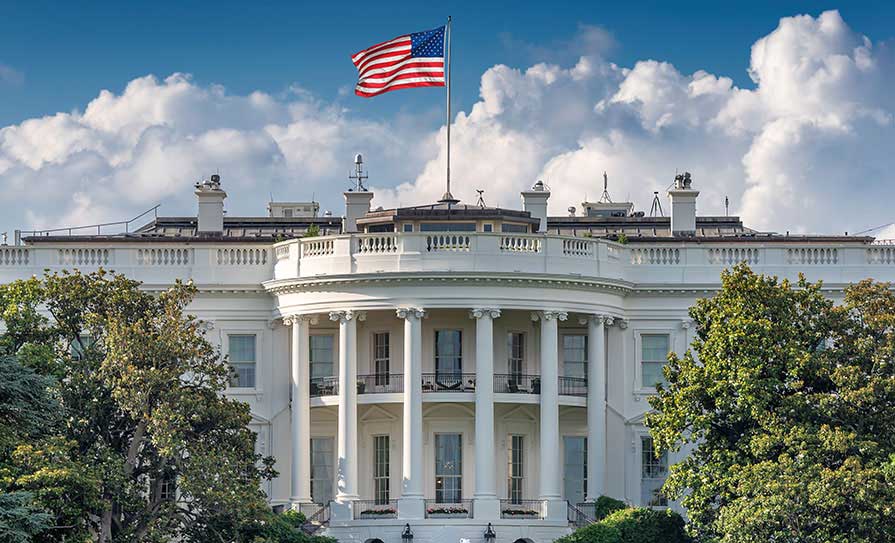As the US presidential election campaign heats up, the battle lines are increasingly being drawn around abortion, fertility services, and other healthcare issues. Bette Browne reports
THe Supreme Court’s ruling to overturn the 1973 Roe v Wade decision seemed like a significant victory for the Republican Party and its campaign to end the constitutional right to abortion. But it is not turning out that way and Republicans are learning that once you give people rights, they usually tend to want to keep them.
On 24 June 2022, the day of the ruling, US National Public Radio legal affairs correspondent Ms Nina Totenberg said the Supreme Court decision may well mean that “the abortion question will become a focal point in the upcoming elections and thereafter”.
Focal point
The issue did become a focal point in the 2022 congressional elections, as it has in this year’s White House race. Back in 2022, with President Joe Biden’s approval rating in the low 40s amid economic discontent, the Democrats feared staggering losses in Congress. Republicans, on the other hand, were expecting to make significant gains in both the House of Representatives and the Senate and even hoped they could win back both chambers from the Democrats. But the Supreme Court ruling changed all of that.
The loss of the right to abortion brought a backlash, especially from female voters who turned out in huge numbers to back Democratic candidates after an appeal from President Biden, who had called on them to elect candidates who would restore the right to an abortion at the congressional and local level. “Roe [abortion rights] is on the ballot. Personal freedoms are on the ballot. The right to privacy, liberty, equality, they’re all on the ballot,” he declared in an official White House statement following the decision.
On the Republican side, former President Donald Trump immediately took credit for the verdict, attributing it to his nomination of three conservative judges to the Supreme Court.
But, on the ground, as the congressional and state elections neared, things were beginning to look different and a number of states, including Republican-leaning ones, decided to put local voting measures on the ballot that would either protect or limit abortion rights.
In every state where an abortion-related measure was on the ballot, voters chose either to enshrine protections or reject new limits on access. Michigan, California, and Vermont approved ballot initiatives to protect abortion rights in their state constitutions. In conservative Kentucky, voters rejected a ballot initiative that would have explicitly denied constitutional protections for abortion, while in Republican-leaning Ohio, voters overwhelmingly approved a constitutional amendment guaranteeing its citizens the right to abortion access.
“Women in America made their voices heard,” a jubilant President Biden told a crowd of supporters in November 2022 as it became clear the issue had saved his party from disaster. They had managed to hold on to the Senate and stem the Republican tide in the House of Representatives.
Now in his race against Mr Trump, the President and his team are focusing on the threat they say a Republican administration would pose to reproductive rights. They are casting the 2024 race as a choice to protect the right to abortion and contraception from Republicans, who have called for further restrictions after the Supreme Court reversal of Roe v Wade.
“In 2024, a vote for Joe Biden and [Vice-President] Kamala Harris is a vote to restore Roe, and a vote for Donald Trump is a vote to ban abortion across the country,” President Biden’s Campaign Manager, Ms Julie Chavez Rodriguez, said in a statement as the campaign got into high gear in January. “These are the stakes in 2024 and we’re going to continue to make sure that every single voter knows it. When Americans go to the polls on election day this November, they will go knowing that the fate of every American woman’s freedom to make her own healthcare decisions is on the line.”
Meanwhile, Mr Trump is touting his anti-abortion track record. “Nobody has done more in that regard,” he said in January while campaigning in Iowa.
Polls
The strategy of the Democrats was boosted by polls indicating that an overwhelming majority of Americans oppose laws banning abortions without including exceptions. But the issue of abortion is never that simple, especially in an increasingly polarised America. A major poll in June last year, for example, found that 64 per cent of US adults believe abortion should be legal in all or most cases but were divided on how far into pregnancy abortion should be allowed. A total of 73 per cent said abortion should be allowed in the first six weeks of pregnancy, including 58 per cent of people living in states with the strictest bans. But overall support dropped to 51 per cent when it came to allowing abortion in the first 15 weeks of pregnancy.
A map drawn by the Guttmacher Institute research organisation shows that 14 of the 50 US states have total bans on abortion and 10 more states restrict access. Most of these anti-abortion laws include narrow exceptions to protect the life or health of the pregnant woman.
Consequences
But doctors and hospitals can face serious consequences if they misinterpret these medical exceptions.
Doctors accused of violating the state abortion law in Texas, for example, face up to $100,000 (€90,000) in fines or even the threat of life in prison and the loss of their medical licence. Doctors say similar laws in place in other conservative states are having a chilling effect on doctors and their patients.
Dr Julie Lyons, a family medicine physician based in Idaho, told CNN on 10 February: “It’s a little bit terrifying to know that we can’t practise our full scope, that we are now needing to manage and triage patients, often outside of the state, to get the reproductive healthcare that they need.”
At a more local level, some 67 cities and seven counties in the US, many of them in Texas, have passed so-called “sanctuary cities for the unborn” ordinances. These are local laws aimed at banning abortions within the area. Some ordinances prohibit the shipment of drugs used for abortions, while others impose penalties for performing or assisting in abortions for residents.
Executive orders
But many activists have their eyes on a much bigger prize. Republican strategy is increasingly to move the battle lines from states to The White House. If Mr Trump prevails against President Biden, they envisage he would issue further restrictive executive orders on abortion, and perhaps even on contraception.
Executive orders do not constitute legislation, and therefore they do not need approval from Congress. Consequently, Congress cannot directly overturn them. Congress may, however, pass legislation that could impede the execution of an order, such as by withholding funding. Nevertheless, only a sitting US President holds the authority to revoke an existing executive order by issuing a new executive order for that purpose.
These executive orders are powerful instruments. Every US president, including President Biden, has issued at least one, totalling more than 13,731 since George Washington took office in 1789, according to the American Bar Association. Since the Supreme Court overturned the national right to abortion, the current President has used a number of executive orders to protect access to it and to contraception.
On 22 January, for example, he expanded access to contraceptives, making them available at no cost under the Affordable Care Act, as well as improving contraceptive benefits for federal workers and their families.
Abortion opponents, therefore, see such instruments as the perfect vehicle to advance their cause under a Trump presidency and are even hoping for a blanket ban on abortion in all states. Many believe that his past record, especially backing the appointment of three conservative justices to the Supreme Court, is proof that he would deliver for them.
Mr Trump was also the first President to attend the annual ‘March for Life’, America’s largest anti-abortion rally. During his term, the Department of Health and Human Services barred health clinics that referred patients for abortion services from receiving federal funds under a family planning programme. This also cut off federal funds from more than 1,000 clinics, including more than 400 Planned Parenthood affiliates.
But, like his Democratic opponents, Mr Trump is keenly aware of the fact that polls are showing that a growing number of Republican voters are concerned about abortion restrictions. As a result, he has tended to avoid discussing the issue. However, this changed on 8 April when he said on his social media platform, Truth Social, that the issue was best decided by individual states. “The states will determine by vote or legislation or perhaps both. And whatever they decide must be the law of the land. Now, it’s up to the states to do the right thing.”
Mr Trump did not say in that statement whether, if elected this year, he would sign a national abortion ban if one reached his desk. However, on 10 April, CNN reported that he said he would not sign such a ban if elected.
But Mr Trump’s former Vice-President Mike Pence (who is not endorsing Mr Trump in the election) is reported to have said at an anti-abortion conference hosted by the Students for Life group in January that the next President should instruct the Food and Drug Administration to “pull the abortion pill off the market”. The pill he was referring to is mifepristone and thousands of women around the US are now collecting stockpiles of the drug, according to research published that month by JAMA Internal Medicine.
Conservative organisations, such as the Heritage Foundation think tank, suggest that if elected in November, Mr Trump should pursue the issue through executive order. Politico reported on 29 January that the Heritage Foundation’s 2025 Presidential Transition Project, known as ‘Project 2025’, is already drafting executive orders to roll back Biden-era policies that have expanded abortion access.
The President of the Students for Life group, Ms Kristan Hawkins, told Politico: “Due to not having 60 votes in the Senate and not having a firm pro-life majority in the House, I think administrative action is where we’re going to see the most action after 2024 if President Trump is elected.”
Obamacare
But many Republicans also recall how a decade-long legal and congressional campaign to repeal former President Barack Obama’s health insurance legislation, known as Obamacare, ultimately failed. This was largely because it had become hugely popular among the additional 40 million Americans who, until it became law, couldn’t afford insurance cover and backed Democratic lawmakers who protected the law.
Republicans hoped their unpopular campaign against the law would be forgotten and, to a great extent, it was. But then in November 2023, Mr Trump declared on his Truth Social site that he was “seriously looking at alternatives” and that the failed repeal and replace effort was “a low point for the Republican Party”.
Despite Mr Trump’s intervention, Republicans are wary of re-running what proved to be a losing battle against Obamacare. They have realised that once people had access to affordable health insurance they didn’t want to give it up. Indeed, a month after Trump’s remarks, a poll by the Kaiser Family Foundation showed that only 32 per cent of Republican voters thought it was very important for candidates to talk about the future of the Affordable Care Act.
Like the failed campaign against Obamacare, Republicans were hoping the consequences of the 2022 Supreme Court ruling might fade from voters’ minds by November.
IVF ruling
Indeed, that might well have happened if it hadn’t been for an extraordinary ruling by another Supreme Court this year in the state of Alabama.
A ruling from the Alabama Supreme Court on 16 February declared that embryos created through IVF should be considered children. The ruling grew out of lawsuits by families against a fertility clinic and a hospital for failing to properly safeguard frozen embryos, resulting in their destruction. The ruling now allows parents in the case to sue for wrongful death of their minor children.
The wider impact on IVF treatments has been profound. Several of Alabama’s IVF clinics have since paused their services out of real concern of the civil – and potential criminal – liability that their doctors and patients might face. Doctors and patients, along with lawmakers, are also raising concerns about the wider consequences of the ruling for healthcare and reproductive technology.
The American Cancer Society and its advocacy affiliate, the American Cancer Society Cancer Action Network, issued a statement on 23 February regarding the matter.
The statement, from the CEO of both groups, Dr Karen Knudsen, said they were “deeply concerned [about the ruling] and the negative impact it may have on cancer patients, survivors, and their families. This decision has already caused multiple clinics to pause in vitro fertilisation treatments due to fear of criminal and civil liability against providers and patients.”
The statement continued: “Cancer patients and survivors often rely on IVF to build families after treatment. Fertility preservation care is essential for more than two-thirds of newly diagnosed adolescents and young adults with cancer. The Alabama Supreme Court ruling is already resulting in major legal hazards for providers offering fertility treatments, and healthcare access challenges for their patients by erecting barriers to care and threatening a person’s ability to preserve fertility prior to initiating cancer treatment or have children after undergoing treatment.”
The Wrongful Death of a Minor Act originated in 1872. When it was enacted, in vitro fertilisation hadn’t been developed yet. This marks the inaugural instance of applying the statute’s definition of a minor or child to an embryo in a laboratory setting.
“There was real concern about the legal consequences given that these embryos, these in vitro embryos, have been declared persons under the law in Alabama,” Dr Joanne Rosen, an expert on health policy and reproductive law, said in a podcast by the Johns Hopkins School of Public Health.
“This is the first time ever that the definition of a minor or a child under that statute has been applied to an embryo that exists in a lab.”
There are over a million and a half embryos currently frozen across the US. “The anti-abortion movement may find that it collides with itself in a way: Abortion terminates pregnancy and IVF exists to create pregnancy.”
It is creating a dilemma, too, for politicians in this election year. A week after the ruling, Mr Trump said he supported preserving access to IVF treatments.
“Under my leadership, the Republican party will always support the creation of strong, thriving, healthy American families. We want to make it easier for mothers and fathers to have babies, not harder! That includes supporting the availability of fertility treatments like IVF in every state in America,” he wrote on Truth Social in February.
But that didn’t stop President Biden from immediately criticising the former President in a statement. “A court in Alabama put access to some fertility treatments at risk for families desperately trying to get pregnant. The disregard for women’s ability to make these decisions for themselves and their families is outrageous and unacceptable. Make no mistake: This is a direct result of the overturning of Roe v Wade.”
Mr Trump’s former rival for the White House who lost to him in the 2016 race, Ms Hillary Clinton, suggested on X (formerly Twitter) that contraception restrictions could be next. “They came for abortion first. Now it’s IVF and next it’ll be birth control. The extreme right won’t stop trying to exert government control over our most sacred personal decisions until we codify reproductive freedom as a human right.”
On 28 February, Republicans in the US Senate blocked passage of a Bill by Democrats to protect access to in vitro fertilisation. “It’s a little personal when a majority male state Supreme Court suggests that people like me who became pregnant with the help of modern medicine should be in jail cells and not nurseries,” said the Bill’s author Senator Tammy Duckworth, who is the mother of two daughters conceived through IVF.
“Clearly, those bragging about overturning Roe v Wade have no clue about the power of women in America,” President Biden declared to congressional lawmakers in his State of the Union address on 7 March. “But they found out when reproductive freedom was on the ballot and won in 2022, 2023, and they will find out again in 2024.”













Leave a Reply
You must be logged in to post a comment.